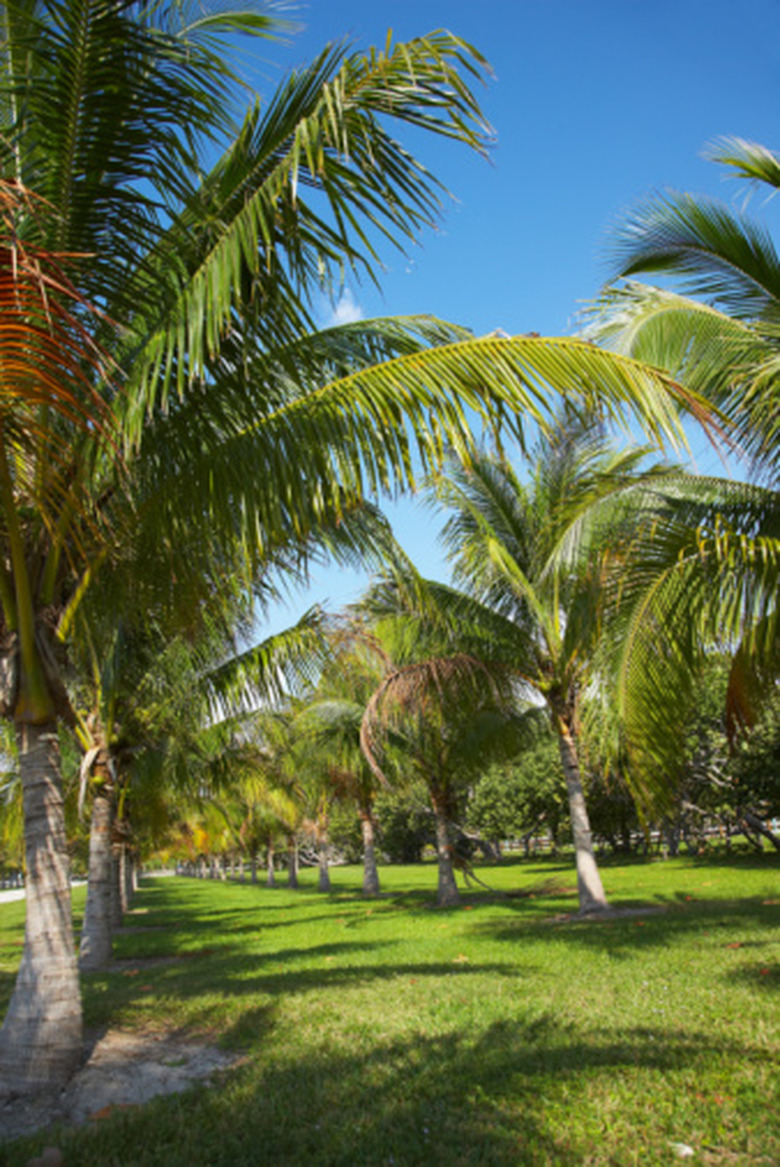Will Coconut Trees Grow In California?
The coconut palm (Cocos nucifera) is thought to be native to tropical regions of the South Pacific and the Malay Archipelago, so its temperature requirements are hot and humid with a year-round, frost-free climate.
Requirements
The coconut palm can only be planted in United States Department of Agriculture Plant Hardiness Zones 10b and 11, which are tropical and subtropical regions of the United States where the temperature does not regularly dip below 35 degrees. According to the USDA Plants Database website, coconut palms need 365 days per year of frost-free climate, and will suffer if temperatures hit below 18 degree.
California's USDA Hardiness Zones
According to the website Digitalseed.com, California's USDA Plant Hardiness Zones range from 5a to 11. The only regions of California that will support the coconut palm are along the southwestern coast, where temperatures remain balmy.
Maturity and Germination Temperatures
For a mature coconut palm to survive, the average temperature should hover around 72 degrees year-round. However, during the first six-month germination period, which may exist indoors in a nursery or greenhouse, the average temperature must range between 90 and 100 degrees.
- The coconut palm (Cocos nucifera) is thought to be native to tropical regions of the South Pacific and the Malay Archipelago, so its temperature requirements are hot and humid with a year-round, frost-free climate.
- According to the USDA Plants Database website, coconut palms need 365 days per year of frost-free climate, and will suffer if temperatures hit below 18 degree.
Palm Trees & Coconut Trees
Everyone knows what a palm tree looks like even if they haven't seen one in person. Because coconuts come from palm trees, most people assume that a palm tree and a coconut tree are the same thing. This class of tree contains more than 3,000 species and over 230 families. Palm trees produce both fruit and flowers. They grow in pointed, narrow shapes extending outward from the stem. The other kind of leaves grow at the very end of the stem and are larger and spread out almost in the shape of hands. Palm trees are of varying heights and thicknesses, and the tallest varieties can grow up to 197 feet tall. Date palms are a species of the palm family. Date palms have been critically important throughout history and have provided food for human beings since the beginning of measured time. Female date palm seeds need to be pollinated by male date palm trees. However, only a specific species of palm trees bear coconuts. they're strong and their roots extend deep into the soil. The uses for the coconut are extensive and have been enjoyed by human beings since the beginning of time. People dry and eat coconut meat, drink the water, use the oil for a variety of purposes and even use the husk. Many world economies rely heavily on trading coconuts, and It's a critical part of life on almost every continent in the world. The husk itself is used for charcoal, fuel, floor polishing, an insect repellent and a skin exfoliator. Inside the shell is coconut water. Coconut water is consumed regularly in tropical areas where the fruit is found. It restores the body's balance of electrolytes and can be used as an emergency infusion because it's capable of mixing safely with blood. It also dissolves kidney stones. Coconut oil is known to reduce wrinkles and soften and moisturize the skin. It can remove head lice, decrease the appearance of varicose veins, work to condition the hair and improve the skin's tone and elasticity.
- Everyone knows what a palm tree looks like even if they haven't seen one in person.
- Female date palm seeds need to be pollinated by male date palm trees.
- It restores the body's balance of electrolytes and can be used as an emergency infusion because It's capable of mixing safely with blood.
References
- United States Department of Agriculture: Coconut Palm Characteristics
- Digital Seed: USDA Plant Hardiness Zones – California
- Owlcation: Different Uses for a Coconut
- Digital Journal: The coconut palm: A tree of life
- The Bump: Coconut Palm Tree Information
- MNN:10 surprising facts about palm trees
- Scientific American: Coconuts: not indigenous, but quite at home nevertheless
- Jungle Music: Date Palms – The True Date Palm and other Species of Phoenix Palms
- Dutch Plantin: Coconut palm trees versus oil palm trees
